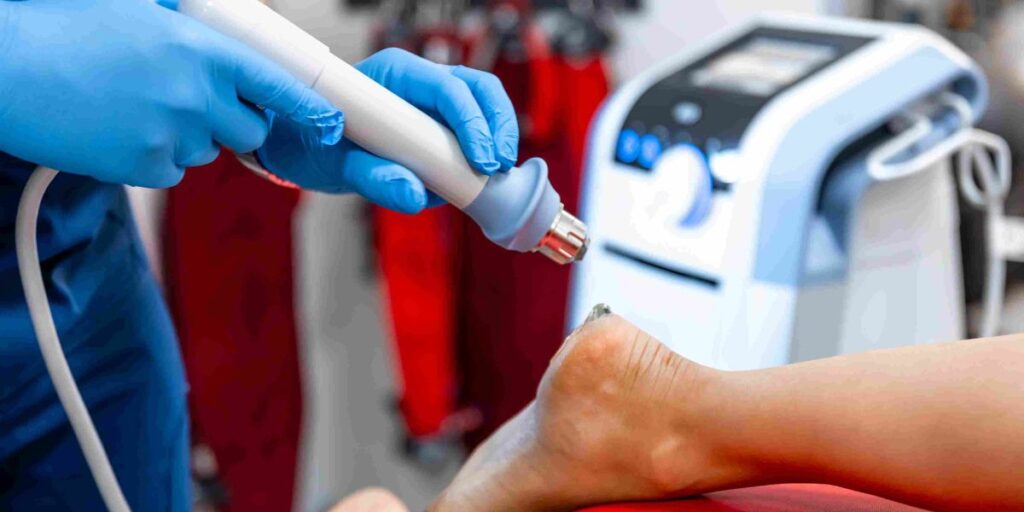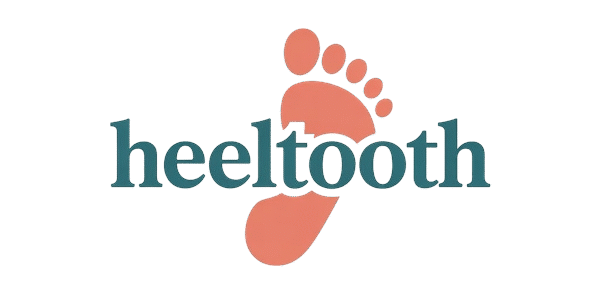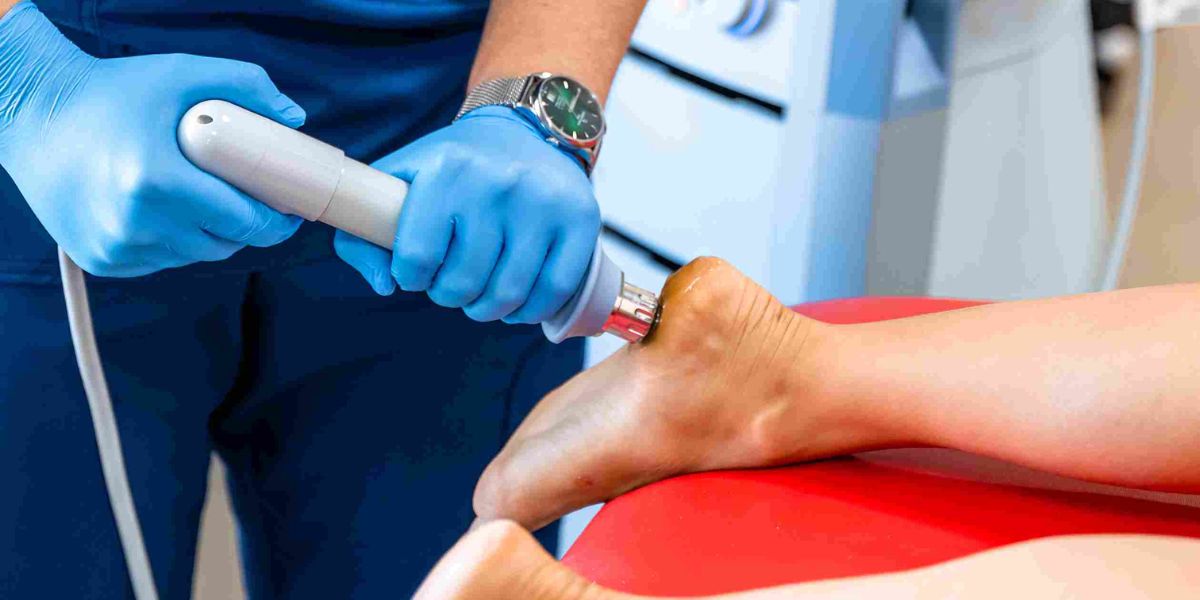Shockwave treatment for plantar fasciitis
Shock wave treatment for plantar fasciitis is changing the way we handle persistent heel pain. If you’ve been dealing with sharp, stabbing discomfort in your heel, especially when you take your first steps in the morning, you might be experiencing plantar fasciitis symptoms. This painful condition affects the thick band of tissue that supports the arch of your foot. Traditional treatments like rest and ice can help, but when those don’t work, extracorporeal shockwave therapy (ESWT) offers a powerful, non-invasive alternative. It’s a proven, non-surgical foot pain solution that encourages natural healing. Many USA podiatry clinics now offer this therapy to patients who want faster, long-term foot pain relief without surgery or downtime.
Overview of Shockwave Therapy
So, how does shockwave therapy work for this condition? The treatment uses sound waves to stimulate healing in the damaged plantar fascia. This process helps increase blood flow and break down scar tissue in the heel. Known formally as extracorporeal shockwave therapy (ESWT), this treatment has shown strong results in reducing foot inflammation and restoring mobility without surgery.
One big reason people turn to shockwave treatment for plantar fasciitis is because it’s an outpatient procedure. That means no hospital stay is required, and patients can often walk right after the session. It’s a quick solution that targets the root of the problem, not just the symptoms. And yes, the benefits of shockwave therapy include faster healing, reduced pain, and improved quality of life.
Indications and Suitability
If you’ve been in pain for more than six months and other methods haven’t worked, this could be the best treatment for plantar fasciitis in USA for you. Ideal candidates include people with walking pain, tight calves, and chronic heel pain that affects their ability to move around freely. Athletes and workers who stand all day also benefit greatly from this therapy.
However, not everyone is a candidate. Pregnant women, people with blood clotting disorders, or those with metal implants in their feet should not get shockwave therapy. It’s also important to check with USA podiatry clinics to make sure it’s safe for you. Your podiatrist will review your history before starting any treatment plan.
Preparing for Shockwave Therapy
Before starting treatment, your foot will be examined, and you may need X-rays to check for heel spurs or other bone issues. Your doctor will also check your medical background. It’s important to avoid anti-inflammatory medications for a few days before treatment, as they may reduce the effects of the therapy.
You should wear comfortable clothes and avoid lotions or creams on your foot that day. Since this is an outpatient procedure, you won’t need anesthesia. The process is simple and requires minimal prep, making it much easier than surgery or injections.
The Shockwave Treatment Procedure
Wondering what happens during shockwave therapy? The session usually lasts about 15 to 20 minutes. The doctor places a device against your heel that sends sound waves deep into the tissues. These waves trigger the body’s natural healing process. You might feel slight discomfort, but it’s usually tolerable without any anesthesia.
The number of sessions for shockwave therapy can vary. Most patients need about 3 to 5 sessions, spaced a week apart. Each session builds on the last, helping your foot heal naturally and steadily. The great part? You can walk out the same day and even drive yourself home.
| Session | Duration (mins) | Pain Level (1–10) | Recovery Time |
| 1 | 15 | 3–5 | Minimal |
| 2 | 20 | 2–4 | Minimal |
| 3 | 15 | 1–3 | Minimal |

Post-Treatment Care and Recovery
After your appointment, it’s best to rest your foot for the day. Some mild soreness or swelling is normal. This is part of the body’s healing process. Cold packs can help reduce foot inflammation, and you should avoid high-impact activities for a few days.
So, how long to recover from shockwave therapy? Most people feel improvement within two to three weeks, but full recovery might take 6 to 12 weeks. To speed up healing, many doctors suggest adding physical therapy for plantar fasciitis and wearing orthotic shoe inserts to support your arch.
Safety and Side Effects
Now let’s talk about the side effects of shockwave therapy. The treatment is FDA-approved and widely used in USA podiatry clinics. Most patients report mild bruising or soreness after sessions. Serious side effects are rare, and there’s no cutting or medication involved, which lowers risks even more.
It’s one of the safest options for heel pain treatment, especially for people looking for a non-surgical foot pain solution. You don’t have to worry about stitches, scarring, or hospital stays. The main thing is to follow aftercare instructions and avoid overusing your foot too soon.
Managing Missed or Delayed Sessions
Life gets busy, and you might wonder what happens if you miss a session. Missing one appointment might delay your progress slightly, but it won’t ruin your results. You should always let your doctor know if you can’t attend, so they can adjust your plan.
Try not to delay treatments too often. Keeping the sessions close together helps you get the full benefit of this plantar fascia therapy. The healing process works best when it’s done in stages without long breaks in between.
Alternative and Complementary Treatments
Some people combine shockwave treatment for plantar fasciitis with other options. These include orthotic shoe inserts, massage therapy, and taping methods. Others try acupuncture, dry needling, or cold laser therapy. While not all have the same evidence behind them, they may help reduce symptoms.
If nothing helps after several months, surgery might be discussed. But most doctors recommend trying at least six months of non-invasive methods first. Physical therapy for plantar fasciitis remains a strong backup and can be used before, during, or after shockwave treatment for the best results.
FAQs
Q: Does shockwave therapy really work for plantar fasciitis?
Yes, it’s highly effective for most people, especially those with chronic pain that hasn’t responded to other treatments.
Q: What are the drawbacks of shockwave therapy?
Some patients experience mild pain, bruising, or swelling, and results can vary depending on the severity of the condition.
Q: How much does shock wave therapy cost for plantar fasciitis?
In the USA, it typically costs between $300 to $600 per session, and most people need 3 to 5 sessions.
Q: Can you walk after shock wave therapy?
Yes, you can walk immediately after, but it’s best to avoid intense activity for 24–48 hours.
Q: What not to do after shockwave treatment?
Avoid running, heavy lifting, or high-impact exercises for a few days to allow proper healing.
Welcome to Heel Tooth! I’m Lee Marvin.

